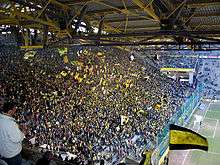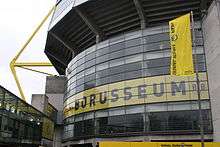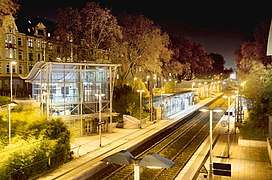Westfalenstadion
Westfalenstadion (German pronunciation: [vɛstˈfaːlnˌʃtaːdi̯ɔn])[5] is a football stadium in Dortmund, North Rhine-Westphalia, Germany, which is the home of Borussia Dortmund. Officially called Signal Iduna Park [zɪɡˌnaːl ʔiˈduːnaː ˌpaʁk][6] for sponsorship reasons, the name derives from the former Prussian province of Westphalia.
Westfalenstadion BVB Stadion Dortmund (UEFA competitions) | |
 UEFA | |

| |
| Full name | Signal Iduna Park |
|---|---|
| Former names | Westfalenstadion FIFA World Cup Stadium Dortmund (2006 FIFA World Cup) |
| Location | Strobelallee 50 44139 Dortmund, North Rhine-Westphalia, Germany |
| Owner | Borussia Dortmund GmbH & Co. KGa[1] |
| Operator | Borussia Dortmund GmbH & Co. KGa |
| Executive suites | 11 |
| Capacity | 81,365 (domestic matches),[2] 65,829 (international matches)[3] Capacity history
|
| Record attendance | 83,000 |
| Field size | 105 by 68 m (344 by 223 ft) |
| Construction | |
| Built | 1971–1974 |
| Opened | 2 April 1974 |
| Renovated | 1992, 1995–99, 2002–03, 2006 |
| Construction cost | DM32.7 million (1974) estimated €200 million (2006) |
| Architect | Planungsgruppe Drahtler |
| Tenants | |
| Borussia Dortmund (1974–present) Germany national football team (selected matches) | |
The stadium is one of the most famous football stadiums in Europe and is renowned for its atmosphere.[7][8] It has a league capacity of 81,365 (standing and seated) and an international capacity of 65,829 (seated only).[2][3] It is Germany's largest stadium, the seventh-largest in Europe, and the third-largest home to a top-flight European club after Camp Nou and the Santiago Bernabéu Stadium. It holds the European record for average fan attendance, set in the 2011–2012 season with almost 1.37 million spectators over 17 games at an average of 80,588 per game.[6] Sales of annual season tickets amounted to 55,000 in 2015.[9]
The 24,454 capacity Südtribüne (South Bank) is the largest terrace for standing spectators in European football.[10][11] Famous for the intense atmosphere it breeds, the south terrace has been nicknamed Die Gelbe Wand, meaning "The Yellow Wall".[11] The Borusseum, the museum of Borussia Dortmund, is near the stadium.
The stadium hosted matches in the 1974 and 2006 FIFA World Cups. It also hosted the 2001 UEFA Cup Final. Various national friendlies and qualification matches for World and European tournaments have been played there as well as matches in European club competitions.
History
Plans to construct a new stadium were drawn up in the 1960s, as the need arose to expand and refurbish the traditional ground of Borussia Dortmund, the Stadion Rote Erde ("Red Soil Stadium"). Following the historic triumph in the 1966 Cup Winners' Cup (Dortmund was the first German team to win a European club title), it became clear that the Stadion Rote Erde was too small for the increasing number of Borussia Dortmund supporters. The city of Dortmund, however, was not able to finance a new stadium and federal institutions were unwilling to help.
In 1971, Dortmund was selected to replace the city of Cologne, which was forced to withdraw its plans to host games in the 1974 FIFA World Cup. The funds originally set aside for the projected stadium in Cologne were thus re-allocated to Dortmund. However, architects and planners had to keep an eye on the costs due to a tight budget. This meant that plans for a 60 million DM oval stadium featuring the traditional athletic facilities and holding 60,000 spectators had to be discarded. Instead, plans for a much cheaper 54,000 spectator football arena, built of pre-fabricated concrete sections, became a reality. Ultimately, the costs amounted to 32.7 million DM, of which 1.6 million DM were invested in the refurbishment of the Stadion Rote Erde. The city of Dortmund, initially burdened with 6 million DM, only had to pay 800,000 DM, and quickly profited from the stadium's high revenues. On 2 April 1974, Borussia Dortmund officially moved into their new home and has played in the Westfalenstadion ever since. Having been relegated in 1972, Borussia Dortmund was the only member of the 2. Bundesliga (second Division) to host the 1974 World Cup games in a completely new stadium. In 1976, after promotion to the Bundesliga, Borussia Dortmund played its first game in Germany's highest division in their new home stadium.
On 16 May 2001, the Westfalenstadion hosted the 2001 UEFA Cup Final between Liverpool and Alavés.
1974 FIFA World Cup
In the 1974 FIFA World Cup, the Westfalenstadion hosted three group stage games and one final group game. The maximum capacity of the stadium was 54,000.
| Date | Team #1 | Res. | Team #2 | Round | Spectators |
|---|---|---|---|---|---|
| 14 June 1974 | 2–0 | Group 2 | 25,000 | ||
| 19 June 1974 | 0–0 | Group 3 | 53,700 | ||
| 23 June 1974 | 4–1 | Group 3 | 52,100 | ||
| 3 July 1974 | 2–0 | Group A | 52,500 |
2006 FIFA World Cup
The stadium was one of the venues for the 2006 FIFA World Cup. Due to sponsorship contracts, however, the arena was called FIFA World Cup Stadium Dortmund during the World Cup.
Six games were played there during the tournament, including Germany's first loss ever at the stadium, a 2–0 defeat to Italy. Also, Trinidad and Tobago played their first ever World Cup match at the stadium, against Sweden.
| Date | Time (CET) | Team #1 | Res. | Team #2 | Round | Spectators |
|---|---|---|---|---|---|---|
| 10 June 2006 | 18:00 | 0–0 | Group B | 62,959 | ||
| 14 June 2006 | 21:00 | 1–0 | Group A | 65,000 | ||
| 19 June 2006 | 15:00 | 0–2 | Group G | 65,000 | ||
| 22 June 2006 | 21:00 | 1–4 | Group F | 65,000 | ||
| 27 June 2006 | 17:00 | 3–0 | Round of 16 | 65,000 | ||
| 4 July 2006 | 21:00 | 0–2 | Semifinals | 65,000 |
Layout
Situated directly next to Stadion Rote Erde, the Westfalenstadion is composed of four roofed grandstands, each facing the playing field on the east, south, west and north sides. The eastern and western stands (Ost- und Westtribüne) run the entire length of the field, while the breadth is covered by the north and south stands (Nord- und Südtribüne).
Originally, the corners between the four grandstands remained empty and the spectators appreciated the extensive roof, which covered over 80% of the stands. The eastern and western stands housed the stadium's 17,000 seats, while the 37,000 standing places were housed in the northern and southern stands.
Located on the southern terrace of the stadium is Dortmund's "Yellow Wall", which is the largest free-standing grandstand in Europe with a capacity of 25,000.[12] The "Yellow Wall" gives Westfalenstadion one of the most intimidating home atmospheres in all of Europe, aiding Borussia Dortmund to an unbeaten home campaign in 2012–13 UEFA Champions League.[13] then-Bayern Munich midfielder Bastian Schweinsteiger, when asked whether he feared Dortmund's players or their manager, more, responded by saying "It is the Yellow Wall that scares me the most." [14]
Expansions

The first expansion plans are dated back to 1961, although the funding required was not available until 4 October 1971 when the city council decided to rebuild the stadium between 1971 and 1974 for the FIFA World Cup. As part of the extensions an additional roof was added around the stadium that weighed 3000 tons.
The original capacity of 54,000 was reduced in 1992 due to UEFA regulations. As the standing rows on the entire northern, the lower eastern and the lower western grandstands were converted into seats, the capacity shrank to 42,800. With 26,000 seats (of which 23,000 were covered), the seating in the Westfalenstadion now outnumbered the standing rows.

After Borussia Dortmund won the Bundesliga in 1995, the Westfalenstadion was expanded yet again. In the first private venture stadium expansion in German history, the two main grandstands, the eastern and the western blocks, received a second tier. Covered by a new roof-construction, each section housed an additional 6,000 seats. Thus, the stadium's capacity was restored to the original 54,000, of which the majority (38,500) were now covered seats. Following Dortmund's 1997 UEFA Champions League victory, success and an ever-growing number of enthusiastic fans made it necessary to enlarge the Westfalenstadion yet again. The southern and northern grandstands were enlarged this time, boosting the total capacity to 68,800 spectators. The southern standing ranks ("Die Südtribüne", where the home team's supporters gather) became the largest free-standing grandstand of its kind in the whole of Europe, with a capacity of 25,000.
Now it is considered one of the biggest and most comfortable stadiums in Europe. The last renovation was made for the 2006 FIFA World Cup. The stadium has a glass front, under-soil heating (allowing matches in winter) and the biggest terraced stand. It is Germany’s largest stadium capacity of 81,360. The expansion was realised by the German architectural firm of Architekten Schröder Schulte-Ladbeck. There are four video screens inside the stadium. The fifth screen on the outside of the north stands is smaller, measuring 28 square meters.
Since 1 December 2005, Westfalenstadion carries the name of Signal Iduna Park, under an agreement which lasts until 2021.

When Germany won the World Cup bid in 2000, it became clear that Westfalenstadion would play a leading role in hosting the tournament. However, as the Westfalenstadion failed to fulfill FIFA requirements for hosting semi-finals, it had to be enlarged a third time. Four new stands were built to fill the corners between the existing grandstands, raising the seating capacity for international games from 52,000 to 67,000. Additionally, the new corner elements provide seating and catering to VIP guests, increasing the total number of VIP seats to 5,000. In order to provide the new sections with an unblocked view of the field, the existing interior roof supports were removed and replaced by exterior pylons, which were painted yellow to suit the Borussia Dortmund colors. During the course of those renovations, construction workers found an undetonated 1,000–pound (450 kg) bomb dropped by an Allied bomber in World War II that was only about one metre below the halfway line on the pitch. Bomb disposal experts had to evacuate the stadium and surrounding neighbourhood in Dortmund, which as part of Germany's industrial centre was bombed heavily, before taking an hour to defuse the device.[15]
The stadium now hosts up to 81,365 fans (standing and seated) for league matches, and 65,829 seated spectators for international games where the characteristic Southern grandstand is re-equipped with seats to conform with FIFA regulations. As match ticket prices are among the lowest among Europe's Big Five football leagues (England, Germany, Spain, France and Italy), the stadium attracts many English fans to its games and has starting conducting stadium tours in English.[14]
The stadium is set to undergo some renovation works in 2018 with the stadium's capacity to rise to 81,365 for Bundesliga Matches and 66,099 for international matches.[16] Free wifi is due to be introduced but the club plans to shut off the signal while play is going on so fans will put their smartphones away and pay attention to supporting the team.[14]
Owners
The property of the Westfalenstadion, originally belonging to the city of Dortmund and later sold to the club Borussia Dortmund, was sold to a real estate trust in 2002 when the club was facing serious financial problems. Following that, Westfalenstadion was in the possession of Florian Homm for about two years, it was sold back to a real estate trust with Borussia Dortmund intending to repurchase the stadium gradually up to 2017. However, the club was not able to pay the regular rates in spring 2005 and the holders of the trust agreed in cutting back the asset's interest rates and allowed the club to pay the rates after financial reorganisation. Because of these measures, bankruptcy of the club was avoided and the future of the facility was secured. In 2006, Borussia Dortmund became the new owner by buying the stadium back with the help of a loan from Morgan Stanley. Borussia Dortmund paid off the loan from Morgan Stanley in 2008.[17][18]
In order to reduce debt, the naming rights to the stadium was sold to an insurance company, Signal Iduna. From 2005 until 2021, the stadium is known as the "Signal Iduna Park". During the 2006 FIFA World Cup, the stadium was called "FIFA World Cup Stadium, Dortmund" since Signal Iduna was not FIFA's sponsor.
Transport

Signal Iduna Park can be reached with the Dortmund Stadtbahn (light rail) lines U42 (Theodor-Fliedner-Heim Station), U45 (Stadion Station), U46 (Westfalenhallen Station and also Stadion). The U45 and U46 are unique in that they serve the special station, Stadion, that is open on game days only. Additionally Deutsche Bahn serves the Dortmund Signal-Iduna-Park station with both regularly scheduled and special game-day trains. This station can be reached using regional RB trains from Dortmund Central Station, as well as from other cities in the metropolitan area, such as Hagen, Iserlohn, and Lüdenscheid. However, some supporters usually alight the U42 and S4 at the Möllerbrücke station and walk to Signal Iduna Park through the Kreuzviertel via Lindemannstraße or Arneckestraße.
The stadium can be reached from Dortmund Airport by taking the shuttle bus to the Holzwickede/Dortmund Airport train station, taking train RB59 towards Dortmund Central Station and getting out at Signal Iduna Park.
By car the stadium can be reached via the B 1 Ruhrschnellweg and B 54. Parking is also available at Dortmund University of Technology, where shuttle busses take fans to the stadium.
Surroundings

From the subway station Möllerbrücke visitors approach the stadium through the Kreuzviertel. It is well known for its many bars, clubs, pubs, and cafes, concentrated in the vicinity of Kreuzstraße and Vinkeplatz and create a day and nightlife atmosphere unique from the rest of the city. That's the reason why the subway station and the city quarter is popular by local fans and those visiting of Borussia Dortmund as a last resort for drinking a cheap beer in the numerous Pubs around the Stadium. On match days, many traders sell beer, sausages (Bratwurst) and jerseys on the street. The north side of the stadium is also the site of a lot of exhibition hotels, apartments and the "Mit Schmackes", a football-themed restaurant and fan clubhouse conceived by former Borussia Dortmund player Kevin Grosskreutz.
On the other side of the Autobahn, the Trade fair with its Westfalenhallen and TV Tower called Florianturm affords a marvellous view on the stadium.
References
- Systems, eZ. "Borussia Dortmund simplifies group structure / Corporate News / IR News / BVB Aktie". aktie.bvb.de.
- "Dortmunds Stadionkapazität erhöht sich" (in German). Kicker. 16 July 2015. Retrieved 17 July 2015.
- "SIGNAL IDUNA PARK, Bayern Munich" (in German). stadionwelt.de. Retrieved 26 July 2015.
- "30 Jahre Westfalenstadion" (PDF). Archived from the original (PDF) on 23 February 2014. Retrieved 2 December 2012.
- The syllable that carries the primary stress is phonemically disyllabic /-ˈfaːl.ən-/. In normal speech, /ən/ assimilates to non-syllabic (because of the preceding /l/) [n] and attaches to the previous syllable, so that it is pronounced monosyllabically [-ˈfaːln-]. The pronunciation [-ˈfaːln̩-], with a syllabic [n̩] is not possible.
- "BVB spielt bis 2021 im "Signal-Iduna-Park"" [BVB to play until 2021 in "Signal Iduna Park"] (in German). Ruhr Nachrichten. 9 May 2012. Retrieved 9 May 2012.
- Evans, Tony (9 August 2009). "The top ten football stadiums". The Times. London.
- "The 20 greatest stadiums in European club football". The Telegraph. 7 April 2016.
- "Bundesliga-Vergleich - So viele Dauerkarten verkauften die 18 Klubs!". Sport Bild (in German). Berlin: BILD GmbH & Co. KG. 28 July 2015. Retrieved 1 August 2015.
- Stadt Dortmund sieht Südtribüne als Denkmal (in German) DerWesten, 08.12.2009
- 'In Germany, every game has the feel of a cup final,' The Independent, 16 September 2010
- Calton, Gary (2 December 2012). "Borussia Dortmund's Yellow Wall - in pictures". the Guardian.
- "Archived copy". Archived from the original on 30 December 2013. Retrieved 4 November 2013.CS1 maint: archived copy as title (link)
- "Price of Football 2014: Why fans flock to Borussia Dortmund". 15 October 2014 – via www.bbc.com.
- Ciaran Walsh (6 February 2009). "Berlin airport a graveyard of WW2 bombs". RT. Archived from the original on 10 April 2010. Retrieved 19 March 2010.
- "Borussia Dortmund's Signal Iduna Park expansion: Germany's biggest stadium set to get bigger!". bundesliga.com - the official Bundesliga website.
- "Borussia Dortmund Extends With SPORTFIVE And Totally Eliminates Morgan Stanley Credit Debt". Retrieved 11 August 2020.
- Uersfeld, Stephan. "Borussia Dortmund's connection to their fans is what makes them special". Retrieved 11 August 2020.
Bibliography
- Werner Skrentny (Hrsg.), Das grosse Buch der Deutschen Fussball-Stadien, Göttingen: Verlag Die Werkstatt, 2001
- Gernot Stick, Stadien 2111, Basel: Birkhäuser 2005
External links
| Wikimedia Commons has media related to Signal Iduna Park. |
- Signal Iduna Park, official site (in German)
- Stadium page at the official Borussia Dortmund website
- Atmosphere at Signal Iduna Park
| Preceded by Parken Stadium Copenhagen |
UEFA Cup Final venue 2001 |
Succeeded by De Kuip Rotterdam |
